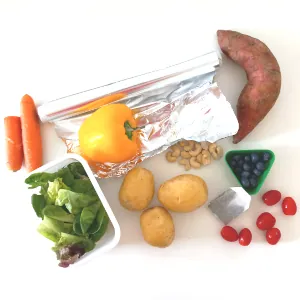Toxins and Other Hidden Dangers in What We Eat

The food we eat is full of beneficial compounds, which we cover in other sections of this site. But you may also be ingesting some harmful substances, especially if you don't choose your foods wisely. These nasties, both natural and man-made, are the topic of this section. Some of these unwanted compounds are toxins in the strictest sense of the word: poisonous substances produced naturally by living organisms. One example is aflatoxins, a group of toxins produced by certain molds. For example, nuts often contain high levels of aflatoxins if not processed and stored properly.
Other toxic substances end up in our food through contamination. You may have heard how mercury gets into fish and from fish into your body, or how an E. coli outbreak was traced back to a batch of contaminated food. Contamination can even happen in your own kitchen if you're not careful, which is why it's so important to follow proper food safety practices if you want to keep pathogens like E. coli, salmonella, and listeria out of your meals.
While hygiene is key, there's more to consider if clean, safe food is important to you. Some toxic substances actually come from the tools and other items we use to prepare and store our food, which has sparked a growing interest in non-toxic kitchenware. Ever heard of the "forever chemicals"? That's the reason why more and more people are looking for not non-stick muffin pans and alternatives to Teflon frying pans. But it's not just non-stick coatings — plastic is another area of concern. One of the most well-known offenders is bisphenol A (BPA), an industrial chemical used in the production of certain plastics and resins. BPA has been linked to a wide range of health problems, including hormone disruption, infertility, asthma, metabolic issues, and even psoriasis.
All the harmful substances and pathogens mentioned above enter our food chain one way or another — but there are also compounds that are naturally present in food. With these, it's not always clear how harmful they really are (see, for example, Nitrites, Nitrates and Cancer). In some cases, it depends on the individual. One person's healthy snack might be another person's trigger. That's where food allergies and intolerances come into play. Fortunately, options like hypoallergenic foods and gluten-free grains (if gluten is your issue) are widely available.
With naturally occurring compounds, how you store and cook food can also make a big difference. Take spinach and nitrates, for example: storage temperature plays a major role in how much of the harmless nitrates convert into potentially problematic nitrites. Another example is the conversion of sugars and the amino acid asparagine into acrylamide during frying, roasting, and other high-temperature cooking. So simply choosing the wrong cooking method can turn certain healthy foods into foods high in acrylamide. And it's not just food — even drinks can contain acrylamide (see Acrylamide in Coffee).
While cooking — especially at high temperatures — often increases the formation of harmful substances, it can also help inactive or eliminate certain compounds. Lectins, which are naturally occurring but potentially problematic compounds, are destroyed by heat. This makes otherwise inedible legumes like beans safe to consume. Some of the best ways to destroy lectins in beans are through pressure cooking and boiling, as moisture and high heat appear to be particularly effective at inactivating these anti-nutrients.
So to sum up, this section of our website deals with all sorts of potential threats hiding in food, whether naturally occurring or picked up along the way. If you're interested in learning more about this topic, scroll down for today's selection of articles (if you're on a smartphone), or check out the sidebar if you're using a desktop.

